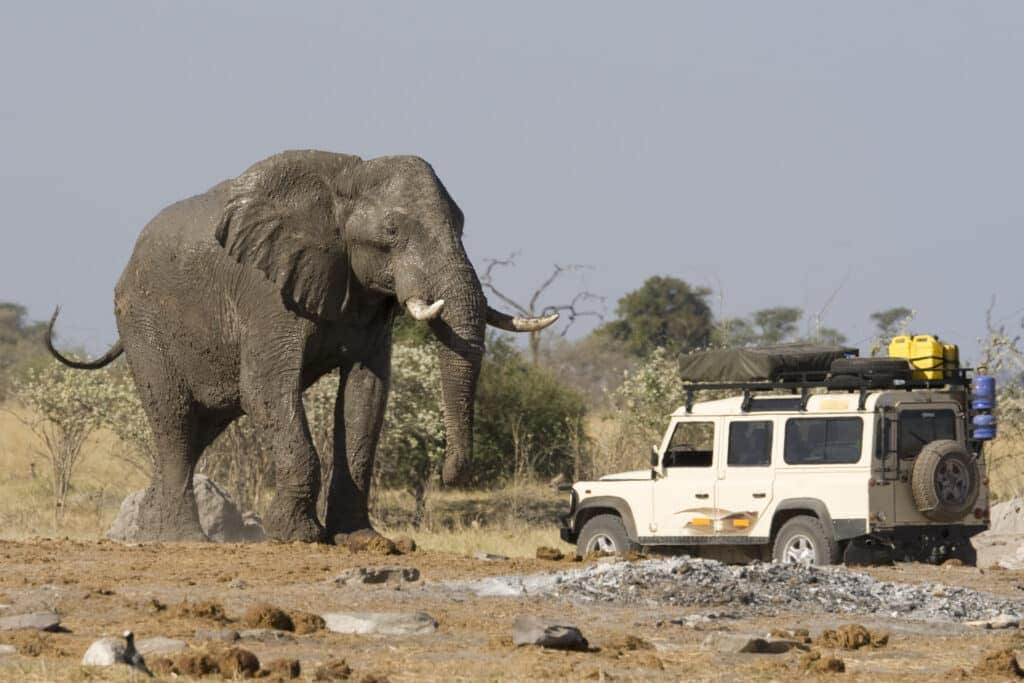You might not know it, but there are actually two subspecies of African elephant: the African bush elephant, and the smaller African forest elephant. The former inhabits savannas, forests, and deserts in Eastern, Southern, and West Africa, while the latter can be found in dense Central and West African rainforests.

In many African cultures and traditions, the elephant symbolizes strength, wisdom, and longevity. In this article, we’ll take a closer look at this keystone species, the largest land mammal on the planet.
Family
![]()
- Living in herds of highly organized social groups of 10 to 100 members, elephants are led by a female leader called a matriarch.
- The matriarch is usually the oldest and most experienced female.
- The matriarch makes decisions for the good of the herd, such as where to go, what to eat, and where to rest.
- Female elephants (cows) stay with the herd for their whole lives.
- Male elephants (bulls) will leave the herd once they reach adolescence at about 14 years old and live alone or with a bachelor herd of other bulls.
- Elephants have the longest pregnancy of all animals, having a gestation period of 22 months.
- A cow will nurse her calf for around 4 years, during which time the calf is milk-dependent.
- Calves will be raised by the whole herd, and it’s not uncommon for the herd to adopt an abandoned or orphaned calf, even from outside the herd.
- Calves have been observed sucking their trunks for comfort, much like a human baby will suck its thumb.
Communication
- Elephants use a wide range of vocalizations, from high-pitched screams and trumpets to infrasound, low-frequency rubles that can be heard by other elephants up to 6 miles away.
- Infrasound can’t be heard by the human ear but is used to communicate when the herd splits apart or to identify other elephants in the area.
Physical Attributes
![]()
- An elephant trunk is made up of about 40,000 muscles.
- A trunk can be thought of as an elephant’s mouth, nose, and hands, and is used for breathing, smelling, sucking up water, picking up objects, and hugging.
- The trunk is both a very powerful and delicate appendage and can tear down a tree or pick a small fruit just as easily.
- Elephants can store up to 9 liters of water in their trunks, and use their trunks to spray water into their mouths or over their bodies to cool off.
- Elephant trunks have two finger-like protrusions at the tip, allowing them to grasp objects with precision.
- If a river crossing is deep, elephants will use their trunks as snorkels.
- Elephant tusks are made of ivory and are an elephant’s only two front teeth.
- Tusks are important tools for an elephant, used to strip bark, dig for water and minerals, and fight for dominance.
- Elephants flap their massive ears to radiate heat away from their bodies, as well as to communicate a wide range of emotions.
- An elephant’s wrinkled skin helps it retain moisture.
Intelligence and Emotions

- With a remarkable memory, elephants can recall the locations of food, water, and their migratory routes.
- Sensitive and complex, these creatures experience a range of emotions from happiness and anger to compassion and empathy.
- Visits to the bones of deceased herd members have been observed, with elephants touching these remains with their trunks.
- Knowledge, including the whereabouts of food and water sources, is passed down through generations in their communities.
- Close bonds of friendship form between them, often leading to playful interactions.
- The herd moves at the pace of its slowest member, ensuring infants are protected by nurturing individuals.
- Within herds, cooperative behaviors are common, with each individual assuming distinct roles and responsibilities.
Importance in the Wild

- With a lifespan of up to 70 years, elephants have a lasting and direct effect on the environments they live in.
- Elephants carve paths through the bush as they travel up to 80 km in a day, which creates passages that other wildlife can move through.
- Elephants tear up grass and bushes when they eat, making room for new vegetation to grow.
- As elephants make their way through the bush, undigested seeds are dispersed in their feces, adding to the biodiversity of the environment.
- When it rains, an elephant’s large footprints create places for water to collect, which smaller animals use as a water source.
- Elephants use their tusks to dig up dry riverbeds and water holes, which benefits other animals in the dry season.
Threats
- African bush elephants are listed as vulnerable by the IUCN, while African forest elephants are listed as endangered.
- Elephants are illegally poached for their ivory tusks, which are considered to have medicinal and status symbol value in some societies and cultures.
- Elephant habitats are being destroyed as humans encroach on their territory.
- Elephants sometimes destroy crops where humans have settled, leading to human-wildlife conflict and retaliatory killings.
Now that you know and understand a bit more about the largest herbivore on earth, why not start planning a luxury safari with the experts at Discover Africa? We can tailor-make a safari tour for you that gets you up close and personal with Africa’s most iconic wildlife.
Author: Devryn Panaino
Published:
Last Update: